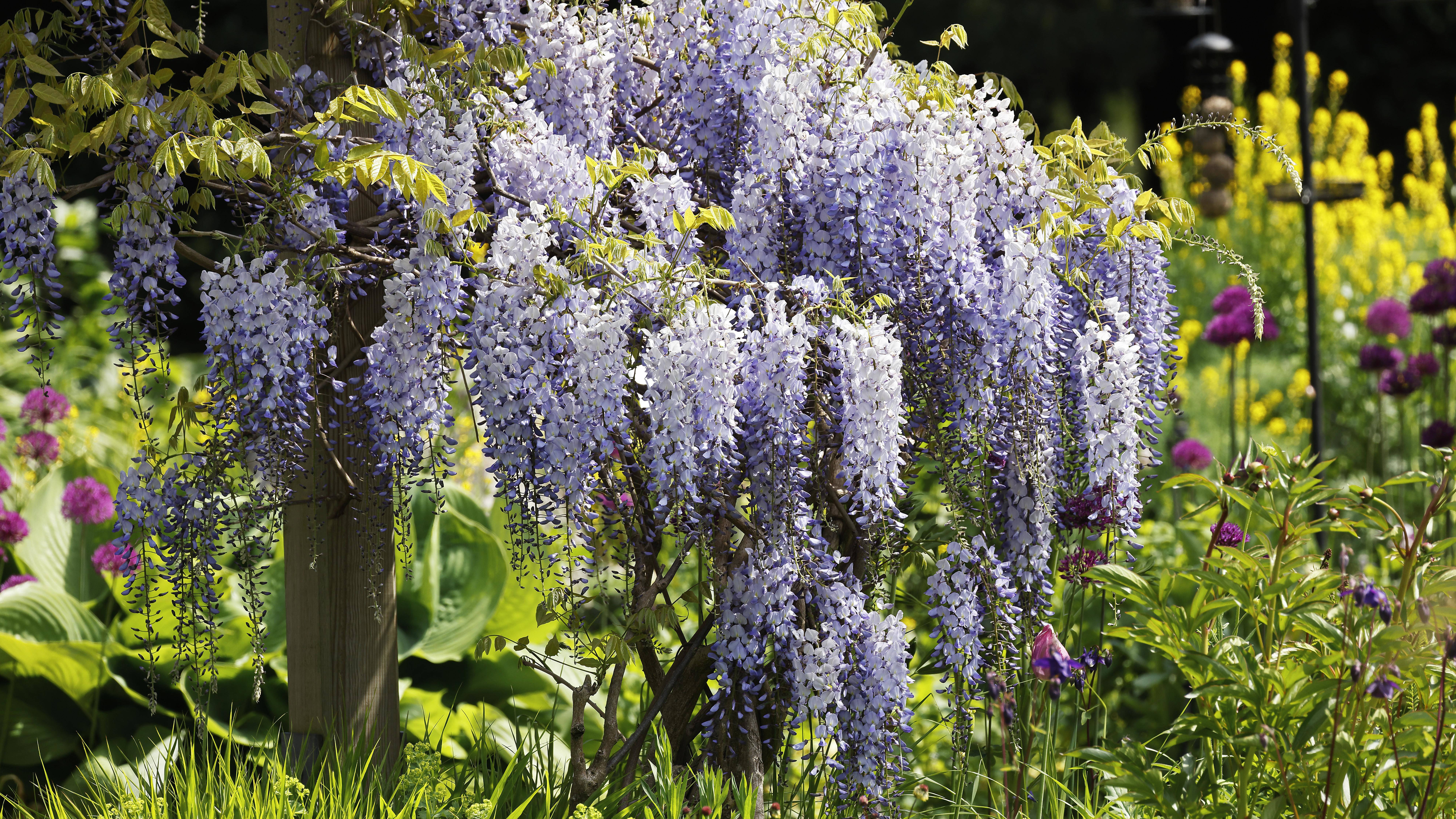
As winter begins to fade and the garden becomes a slightly more inviting (read: less cold and wet) place to spend your time, it might be time to start thinking about getting it ready for spring and, eventually, summer.
If you weren’t already aware, March is a pivotal month for gardeners of any level to prepare their yards for the vibrant bloom of spring. This generally cool, dormant period presents an opportune moment to grab a pair of the best pruning shears and tend to some of the plants you might have, from fruit-bearing apple and pear trees to the ornamental splendours of hydrangeas and wisterias. In fact, here's a bespoke guide on how to prune hydrangeas.
This timing is crucial as it prepares plants for a surge of growth with the onset of warmer weather, ensuring they are not only aesthetically pleasing but also structurally sound and well-positioned to flourish. But which plants exactly should you be looking to prune to ensure they are in tip-top shape ahead of the warmer months?
We’ve enlisted the help of gardening expert Sean Lade, director of Easy Garden Irrigation, to give us the low down on the garden plants that need your attention right now to ensure a lush, vibrant garden once we’ve bid a fond farewell to the cooler months. Here are the plants you should begin pruning right now align with some quick tips in doing so.
What is pruning and why do it?

Before we delve into which of your garden plants might need pruning, let’s try and understand what exactly this practice means for those who don’t already know, how to do it and why it’s so critical when it comes to rejuvenating your garden ahead of summer.
Pruning is the gardener's art of cutting back plants to improve their health, shape and productivity. It involves selectively removing parts of a plant, such as branches, buds or roots, to eliminate unwanted growth, encourage new development, and maintain or improve the plant's structure.
This practice is essential for several reasons. First off, it helps in controlling the size and shape of plants, ensuring they fit well within their space. It removes dead or diseased wood, reducing the risk of pests and diseases. It also promotes air circulation through the plant, decreasing the likelihood of fungal infections while stimulating flowering and fruiting, leading to more abundant blooms and harvests.
Just beware the 7 pruning mistakes you never knew you were making.
Get instant access to breaking news, the hottest reviews, great deals and helpful tips.
The Gardener’s Friend Ratchet Pruning Shears: was $29 now $19 at Amazon
If you need pruning shears for breaking up dead wood, but struggle with the strain on the hands and wrist, we recommend a ratchet design, like this one. It breaks up the movement of closing the shears into several steps to make the action easier. And during our best pruning shears test, we found this model to be one of the top performers. It’s easy to use and features a handy knuckle guard.
7 plants to prune right now
So why is late winter the ideal time to prune your garden plants?
March is a perfect time for pruning many garden plants because it’s during this period that they’re still dormant but on the cusp of spring growth. This means that pruning wounds heal faster as the plant begins to grow in spring, reducing the risk of infection.
Additionally, cutting back plants before they channel energy into spring growth means that the energy is instead directed into the new shoots and branches that form after pruning, leading to a more vigorous and healthy plant.
With all that in mind, let’s see which plants should be the focus of all your pruning efforts right now.
1. Fruit trees (Apples and Pears)

Winter pruning helps shape fruit trees, such as apples and pears, to encourage their fruiting further, explains Lade.
“It’s recommended to prune [such plants] between November and March,” he says.
“This ensures the tree is dormant, and any pruning will only encourage new growth without causing damage to the tree.”
Removing dead or crossed branches is also worth doing to tidy the tree up so it is ready for spring and ensure you open up the canopy for better air circulation.
2. Ornamental Grasses

Late winter is also the ideal time to cut back ornamental grasses such as Maiden grass or purple fountain grass before new shoots emerge. Doing so is relatively easy, simply trim them down to a few inches above the ground.
This encourages fresh, healthy growth and maintains the plant's shape. It’s also a simple way to tidy up the garden and prepare for the impending growth spurt.
G & F 1852-3 Women Soft Jersey Garden Gloves: $11 at Amazon
Combining practicality with pretty, we recommend these women's gardening gloves for an affordable but dependable outdoor sidekick. They ranked as the best gloves for small hands in our best gardening gloves test. We found them to be both comfortable and soft, with good dexterity. Plus, you get three colors in a pack which is amazing value for money.
3. Hydrangeas

The mophead and lacecap varieties of hydrangeas should also be pruned in late winter, recommends Lade.
“Depending on the weather in your area, you may want to hold off until at least February to prune Hydrangeas, as the big deadheads act as protection from harsh weather conditions,” he advises.
“It is best to decide based on your area's current climate. When you have decided, cut back to just above the first pair of healthy buds and remove any weak or damaged stems to encourage healthy regrowth in the spring.”
4. Wisteria

Winter pruning helps establish a strong framework for wisteria plants. They should only need two prunes a year, the second of which should be done in its dormant state after a late summer or early autumn prune.
“Cut back side shoots to two or three buds,” explains Lade, “removing unwanted growth.”
To maintain the desired shape, he recommends pruning the wisteria’s longer shoots.
5. Roses

February and March are the perfect months for pruning most types of roses. Doing so will lead to a significant growth spurt come spring with abundant blooms.
To prune roses successfully, prune back to a bud facing the desired direction for new growth, removing any dead, diseased or inward-growing branches. This not only shapes the rose bush but also improves air circulation and health. For climbing roses, secure any loose canes to their supports after pruning.
6. Clematis

Before new growth begins on any clematis plants you might have in your garden, Lade recommends eliminating any dead or feeble stems.
“Examine each stem from the top down until you locate a pair of buds then prune just above them, eliminating any frail or damaged growth above,” he says.
However, it’s crucial not to prune excessively, as it could result in the loss of flowers.
“To promote a subsequent wave of flowers later in the season, trim back certain stems by cutting to sizable buds or a sturdy sideshoot positioned just below the blossoms.”
7. Lavender

Lavender, with its alluring fragrance and lovely purple blooms, is another plant that deserves some attention during pruning season. Renowned for its resilience and aromatic qualities, lavender thrives when pruned in late winter. This timing encourages the plant to come back stronger than ever in summer with more flowers.
To prune, simply trim back last year's growth, leaving just a few inches of the new shoots intact. This not only maintains the plant's shape but also stimulates the development of fresh, fragrant blooms.
More from Tom's Guide
Lee Bell is a freelance journalist and copywriter specialising in technology, health and fitness and how the latest innovations are shaking up the lifestyle space. From national newspapers to specialist-interest magazines and digital titles, Lee has written for some of the world’s most respected publications during his 12-plus years as a journalist.



